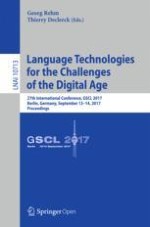1 Introduction
2 Ensemble Parsing
3 Setting
3.1 Parser Ensemble
-
Ensemble 1 (ENS-1): Majority vote of all three parsers agreeing on the annotation (Match-3) or at least two out of three parsers agreeing (Match-2); MATE as the best individual parser serves as the default when all parsers differ from each other.
-
Ensemble 2 (ENS-2): Majority vote of all three parsers agreeing on the annotation (Match-3); MATE serves as the default otherwise, except MATE assigns one of the labels S or OBJA then the annotation of JWCDG is used instead.
3.2 Training Domain
3.3 Test Domain and Gold Standard
4 Results
4.1 Quantitative Results
4.2 Qualitative Results
Parser | False label | Comment |
|---|---|---|
JWCDG | APP (26%) | Default attachment |
S (15%) | Fragments | |
#errors: 262 | ||
MALT | S (64%) | Incomplete sentences |
#errors: 335 | ||
MATE | S (30%) | Fragments |
OBJA (26%) | Confusion of SUBJ/ OBJA | |
#errors: 225 |
